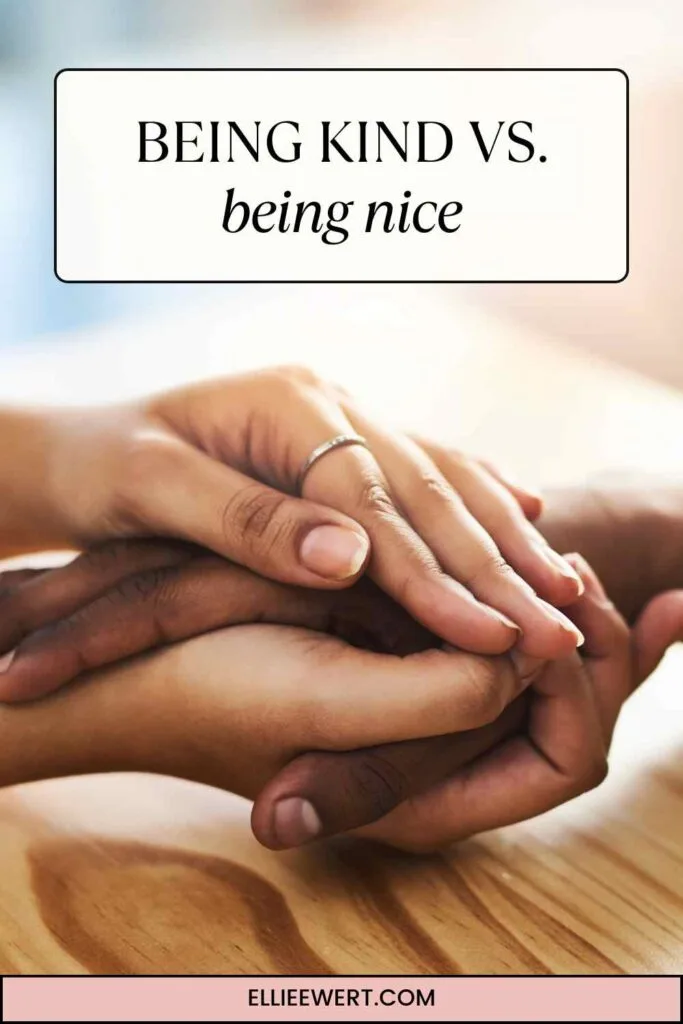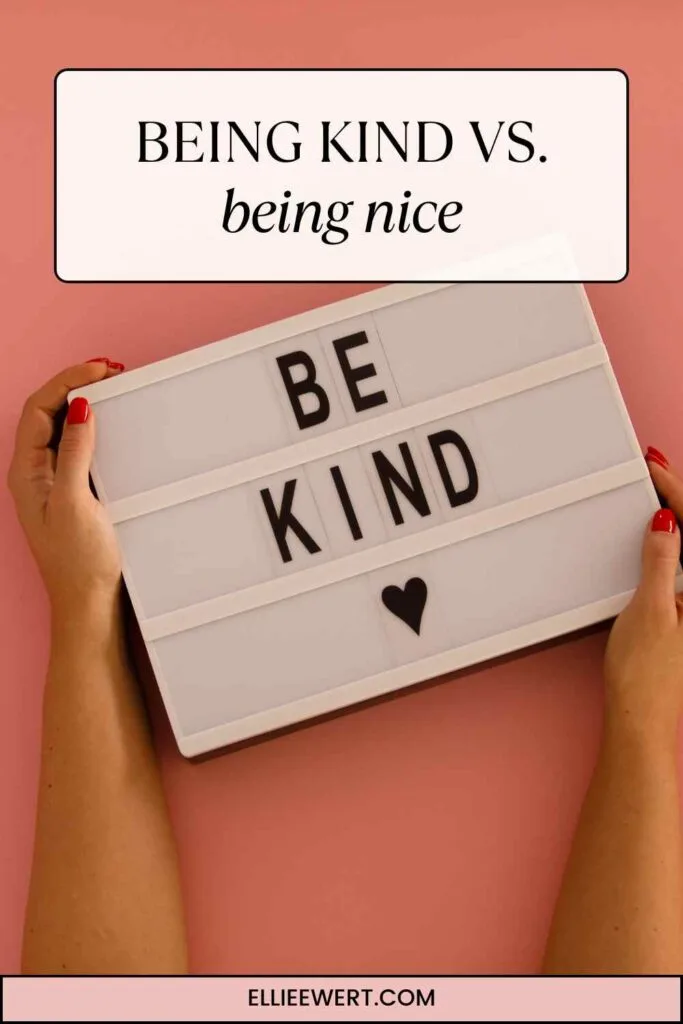Understanding the difference between being kind and being nice can transform your relationships and personal well-being.
This guide will explore the nuances, benefits, and practical ways to practice genuine kindness, helping you build deeper connections and lead a more fulfilling life.
Definitions and Differences
Kindness: Definition and Characteristics
Kindness is often described as the quality of being friendly, generous, and considerate. However, it goes beyond simple actions and delves into the intention behind them.
Here are some key characteristics of kindness:
- Genuine Care: Kindness stems from a sincere desire to help others and improve their well-being.
- Empathy: It involves understanding and sharing the feelings of others.
- Selflessness: Acts of kindness are often done without expecting anything in return.
- Consistency: True kindness is consistent and doesn’t fluctuate based on convenience or mood.
Niceness: Definition and Characteristics
Niceness, on the other hand, is often associated with being pleasant and agreeable. While it can overlap with kindness, it is typically more surface-level. Here are some characteristics of niceness:
- Politeness: Niceness often manifests as good manners and courteous behavior.
- Conflict Avoidance: Nice people may prioritize avoiding confrontation over addressing issues honestly.
- Social Approval: Niceness can sometimes be driven by a desire to be liked or accepted by others.
- Situational: Niceness can vary depending on the situation and the people involved.
Key Differences: Intent, Depth, and Impact
Understanding the differences between kindness and niceness is crucial. Here’s how they diverge:
- Intent:
- Kindness: Motivated by genuine care and concern for others.
- Niceness: Often driven by a desire to be liked or avoid conflict.
- Depth:
- Kindness: Deep and rooted in empathy and selflessness.
- Niceness: Can be superficial and focused on outward behavior.
- Impact:
- Kindness: Leads to meaningful connections and long-term positive effects.
- Niceness: May result in short-term harmony but can lack substance and authenticity.
Examples of Kindness vs. Niceness
To further illustrate the differences, consider these examples:
- At Work:
- Kindness: Offering to help a colleague with their workload because you genuinely want to support them.
- Niceness: Complimenting a colleague’s work to stay in their good graces, even if you don’t mean it.
- In Friendships:
- Kindness: Listening attentively to a friend’s problems and offering thoughtful advice or support.
- Niceness: Agreeing with everything your friend says to avoid any disagreements, even if you have different opinions.
- In Family:
- Kindness: Taking care of a family member who is sick, ensuring they have everything they need.
- Niceness: Saying you’ll help a family member but not following through because it’s inconvenient.
By distinguishing between these two concepts, we can strive to be more authentically kind, leading to richer, more genuine interactions and relationships.

The Psychology Behind Kindness and Niceness
Motivations: Why People Choose to Be Kind vs. Nice
Understanding the motivations behind our actions can help us differentiate between kindness and niceness.
Here’s a look at the driving forces behind each:
- Kindness:
- Empathy: A strong sense of empathy compels individuals to act kindly, as they genuinely feel others’ emotions.
- Altruism: The desire to improve others’ lives without expecting anything in return.
- Personal Values: Kindness is often rooted in deep-seated personal values and principles.
- Niceness:
- Desire for Approval: Many people are nice because they seek social acceptance and approval.
- Conflict Avoidance: Niceness is sometimes a strategy to avoid confrontation and maintain harmony.
- Social Conditioning: Societal norms often encourage people to be nice to fit in and be perceived positively.
Psychological Benefits: How Each Affects Mental Health and Well-Being
Both kindness and niceness can impact our mental health and well-being, but in different ways:
- Kindness:
- Increased Happiness: Acts of kindness release oxytocin, the “love hormone,” which can enhance feelings of happiness.
- Reduced Stress: Helping others can reduce stress and promote a sense of calm and well-being.
- Enhanced Self-Esteem: Genuine kindness boosts self-esteem and confidence, as it aligns with one’s values and sense of purpose.
- Niceness:
- Temporary Relief: Niceness can provide short-term relief from social tensions and conflicts.
- Emotional Drain: Consistently being nice to please others can lead to emotional exhaustion and resentment.
- Superficial Satisfaction: Niceness might offer temporary social acceptance but lacks the deeper fulfillment that kindness provides.
Social Conditioning: How Society Influences Our Understanding and Practice
Society plays a significant role in shaping our perceptions of kindness and niceness. Here’s how:
- Cultural Norms:
- Many cultures prioritize niceness as a social virtue, encouraging individuals to be agreeable and polite.
- Kindness, while valued, may not be as explicitly taught or emphasized in social conditioning.
- Media Representation:
- Media often portrays nice characters as likeable and kind ones as heroic, but the nuances between the two can be blurred.
- Stories of genuine kindness are celebrated, but the day-to-day practice of niceness is more commonly depicted.
- Educational Systems:
- Schools often emphasize politeness and manners (niceness) over teaching empathy and altruism (kindness).
- Programs that promote emotional intelligence and empathy can help foster true kindness from a young age.
Internal vs. External Validation
One of the core differences between kindness and niceness lies in the source of validation:
- Kindness:
- Internal Validation: Acts of kindness provide internal satisfaction and fulfillment, as they align with personal values.
- Self-Respect: Kindness enhances self-respect and integrity, knowing one is acting in line with their principles.
- Niceness:
- External Validation: Niceness often seeks external validation, aiming to gain approval from others.
- Social Approval: Nice actions are frequently performed to maintain a favorable social image and avoid criticism.
By understanding these psychological underpinnings, we can become more mindful of our motivations and strive to practice genuine kindness over mere niceness.
This shift not only benefits our mental health but also fosters deeper and more meaningful connections with those around us.

Real-World Examples
Scenarios: Practical Examples of Kindness vs. Niceness in Various Contexts
Understanding the differences between kindness and niceness can be easier with practical, relatable examples. Here are some scenarios that illustrate how these two concepts manifest in everyday life:
- Workplace:
- Kindness: Sarah notices that her colleague, John, is overwhelmed with his workload. She offers to help him with a project, not to gain favor or recognition, but because she genuinely wants to support him.
- Niceness: Mark compliments his boss on a presentation, even though he didn’t actually think it was that great. He does this to stay in good standing with his boss, aiming for future benefits.
- Friendships:
- Kindness: Emily takes the time to listen to her friend, Lisa, who is going through a tough time. She offers thoughtful advice and continues to check in on her, showing consistent care and concern.
- Niceness: Jake agrees with everything his friend, Tom, says during a conversation, even though he has different opinions. He does this to avoid any potential disagreement and keep the conversation pleasant.
- Family:
- Kindness: Maria helps her elderly neighbor with groceries every week, making sure she has everything she needs and spending time chatting with her to alleviate her loneliness.
- Niceness: Kevin tells his parents he’ll help them with chores, but often makes excuses or does the bare minimum because he finds it inconvenient.
Case Studies: Stories of Individuals Who Exemplify Kindness and Niceness
These case studies highlight individuals who embody the essence of kindness and niceness in their actions:
- Kindness:
- Case Study 1: Fred Rogers, known as Mister Rogers, built a career on genuine kindness. His television show, “Mister Rogers’ Neighborhood,” emphasized empathy, understanding, and self-worth. He often went out of his way to ensure that everyone he met felt valued and heard, demonstrating deep, authentic kindness.
- Case Study 2: Mother Teresa dedicated her life to helping the poorest of the poor. Her work with the Missionaries of Charity was driven by a profound sense of empathy and a desire to alleviate suffering without expecting anything in return.
- Niceness:
- Case Study 1: Jane, a corporate executive, is known for her pleasant demeanor. She always greets her employees with a smile and polite conversation. However, her niceness often masks her reluctance to address workplace issues directly, opting for short-term harmony over long-term solutions.
- Case Study 2: Mike, a high school student, is well-liked because he’s always agreeable and friendly. He never voices his own opinions if they might cause disagreement. His niceness is driven by a fear of conflict and a strong desire to fit in.
Analyzing the Impact of Kindness and Niceness
By examining these scenarios and case studies, we can better understand the impact of kindness and niceness:
- Depth of Connection:
- Kindness: Leads to deeper, more meaningful relationships because it is based on genuine care and empathy.
- Niceness: Often results in superficial relationships that lack depth and authenticity.
- Personal Fulfillment:
- Kindness: Provides a sense of fulfillment and aligns with personal values, leading to greater self-respect.
- Niceness: May offer temporary social acceptance but can lead to internal conflict and emotional drain if it’s not aligned with true feelings.
- Long-Term Effects:
- Kindness: Has long-lasting positive effects on both the giver and receiver, fostering trust and goodwill.
- Niceness: Can maintain short-term peace but might not resolve underlying issues, leading to potential future conflicts.
Understanding these real-world examples helps to clarify the distinction between being kind and being nice, encouraging us to strive for genuine kindness in our interactions.
The Impact of Kindness and Niceness
On Relationships: How Being Kind or Nice Affects Personal and Professional Relationships
The way we interact with others, whether through kindness or niceness, significantly influences our relationships. Here’s how:
- Personal Relationships:
- Kindness: Builds deeper trust and intimacy. When you act kindly, you show genuine concern and empathy, which strengthens bonds and creates lasting connections. Kindness fosters a supportive environment where individuals feel valued and understood.
- Niceness: Maintains surface-level harmony. While being nice can make interactions pleasant, it often avoids addressing deeper issues. Niceness can sometimes mask true feelings, leading to misunderstandings and a lack of genuine connection.
- Professional Relationships:
- Kindness: Encourages collaboration and respect. In the workplace, kindness can lead to a more cooperative and positive environment. Employees who experience genuine kindness from their colleagues and superiors are more likely to be engaged, motivated, and loyal.
- Niceness: Promotes short-term cooperation but may hinder honest communication. Being nice can smooth over minor conflicts, but it may also prevent necessary constructive feedback, leading to unresolved issues and potential resentment over time.
On Self-Perception: How It Shapes Our Self-Esteem and Self-Worth
How we perceive our actions—whether kind or nice—affects our self-esteem and self-worth:
- Kindness:
- Internal Satisfaction: Acts of kindness align with our core values and provide a sense of internal fulfillment. Knowing that our actions positively impact others enhances our self-esteem.
- Self-Respect: Being kind reinforces our integrity and self-respect. It affirms that we are acting in ways that are consistent with our beliefs and moral standards.
- Niceness:
- External Validation: Niceness often seeks approval from others, leading to dependence on external validation for self-worth. This can result in fluctuating self-esteem based on others’ reactions.
- Potential Conflict: When niceness contradicts our true feelings, it can create internal conflict and diminish self-respect. Continually prioritizing others’ approval over our own values can erode our sense of self.
On Society: Broader Social Implications and Community Well-Being
The collective impact of kindness and niceness extends beyond individual relationships to affect society as a whole:
- Community Building:
- Kindness: Strengthens communities by fostering a culture of genuine care and mutual support. Acts of kindness create a ripple effect, encouraging others to also act kindly, thus building a more compassionate society.
- Niceness: Maintains social etiquette and reduces friction. While niceness contributes to polite interactions and social cohesion, it may not address deeper societal issues or inspire meaningful change.
- Social Trust:
- Kindness: Enhances social trust and cooperation. Communities where kindness is prevalent tend to have higher levels of trust, cooperation, and collective well-being.
- Niceness: Ensures social order but may lead to superficial relationships. While niceness can help maintain social order, it might not foster the deep trust and solidarity needed for a resilient and thriving community.
Practical Implications: How to Integrate Kindness into Daily Life
To maximize the positive impact of kindness, consider these practical steps:
- Intentional Actions: Reflect on your motivations and strive to act from a place of genuine care rather than seeking approval.
- Empathetic Listening: Practice active listening to understand others’ perspectives and needs, demonstrating empathy and support.
- Consistent Practice: Make kindness a consistent part of your daily interactions, regardless of convenience or immediate benefit.
- Honest Communication: Balance kindness with honesty. Being kind doesn’t mean avoiding difficult conversations; it means addressing them with empathy and respect.
By understanding and practicing these principles, we can foster deeper, more meaningful relationships, enhance our self-esteem, and contribute to a more compassionate and connected society.

Cultivating Kindness Over Niceness
Self-Awareness: Understanding Your Own Tendencies
The first step to cultivating kindness over niceness is developing self-awareness. Recognize your patterns and motivations:
- Self-Reflection: Take time to reflect on your actions and motivations. Are you being nice to avoid conflict or to be liked? Or are you acting out of genuine concern for others?
- Identify Triggers: Notice situations where you tend to default to niceness rather than kindness. Understanding these triggers can help you respond more mindfully.
- Journaling: Keep a journal to document your interactions and reflect on whether they were driven by kindness or niceness. This practice can help you gain clarity and make intentional changes.
Practical Tips: How to Practice Kindness Intentionally
Incorporating intentional acts of kindness into your daily life can create lasting positive changes. Here are some practical tips:
- Small Acts: Start with small, consistent acts of kindness. Hold the door open for someone, offer a sincere compliment, or help a neighbor with their groceries.
- Active Listening: Show genuine interest in others’ feelings and experiences. Listen without interrupting and offer your full attention.
- Random Acts of Kindness: Perform random acts of kindness without expecting anything in return. Pay for someone’s coffee, leave a kind note for a colleague, or donate to a charity.
- Express Gratitude: Regularly express gratitude to others. Let people know that you appreciate them and acknowledge their efforts and contributions.
Overcoming Challenges: Common Obstacles and How to Address Them
Practicing kindness can sometimes be challenging. Here are some common obstacles and strategies to overcome them:
- Time Constraints:
- Solution: Incorporate small acts of kindness into your daily routine. Even a few minutes can make a difference.
- Emotional Exhaustion:
- Solution: Practice self-care to recharge. Kindness should not come at the expense of your well-being. Ensure you are also kind to yourself.
- Fear of Vulnerability:
- Solution: Understand that showing kindness may make you feel vulnerable, but it also builds deeper connections. Start with small steps and gradually increase your acts of kindness.
- Unreciprocated Kindness:
- Solution: Remember that kindness is about giving without expecting anything in return. Focus on the positive impact you are making, regardless of others’ responses.
Transforming Niceness into Kindness
If you find yourself often defaulting to niceness, here’s how you can transform those actions into genuine kindness:
- Shift Your Mindset: Move from seeking approval to genuinely caring for others’ well-being. Focus on the impact of your actions rather than the immediate response.
- Be Honest: Practice honesty in your interactions. Being kind doesn’t mean avoiding difficult truths. Address issues with empathy and respect, but don’t shy away from necessary conversations.
- Build Empathy: Work on developing your empathy skills. Try to see situations from others’ perspectives and understand their feelings and needs.
- Set Boundaries: Establish healthy boundaries to prevent burnout and ensure that your kindness is sustainable. It’s okay to say no when necessary.
Real-Life Applications
To see how these principles can be applied in everyday life, consider these examples:
- Workplace:
- Instead of simply agreeing with a colleague to keep the peace, provide constructive feedback that helps them improve and grow.
- Friendships:
- Rather than just being agreeable, offer genuine support and be there for your friends during difficult times, even if it means having tough conversations.
- Family:
- Practice consistent acts of kindness, such as helping with chores without being asked or spending quality time together without distractions.
By intentionally practicing kindness and addressing these challenges, you can cultivate deeper, more meaningful connections and make a positive impact on the lives of those around you.
Teaching Kindness
For Parents: Instilling Kindness in Children
Teaching kindness to children is essential for their development and the betterment of society. Here are some strategies for parents:
- Lead by Example: Children learn by observing their parents. Demonstrate acts of kindness in your daily life, whether it’s helping a neighbor or showing compassion to a friend.
- Encourage Empathy: Teach children to understand and share the feelings of others. Use stories and role-playing to help them see situations from different perspectives.
- Praise Kind Behavior: Reinforce kind actions by praising and acknowledging them. Highlight the positive impact their kindness has on others.
- Involve Them in Kind Activities: Engage children in activities that promote kindness, such as volunteering, helping with community projects, or making gifts for friends and family.
For Educators: Creating a Culture of Kindness in Schools
Educators play a pivotal role in fostering a culture of kindness in schools. Here are some ways to integrate kindness into the classroom:
- Kindness Curriculum: Incorporate lessons on kindness, empathy, and compassion into the curriculum. Use books, videos, and discussions to explore these concepts.
- Model Kindness: Demonstrate kind behavior in your interactions with students and colleagues. Show respect, patience, and understanding.
- Encourage Kind Acts: Create opportunities for students to practice kindness, such as class projects, peer support programs, and random acts of kindness challenges.
- Recognize and Reward Kindness: Acknowledge and celebrate acts of kindness in the classroom. Use rewards, certificates, and public recognition to reinforce positive behavior.
For Leaders: Promoting Kindness in the Workplace
Leaders can cultivate a culture of kindness in the workplace, leading to a more positive and productive environment. Here’s how:
- Set the Tone: Lead by example. Demonstrate kindness in your interactions with employees, showing respect and empathy.
- Encourage Collaboration: Foster a collaborative environment where team members support and help each other. Encourage teamwork and collective problem-solving.
- Provide Support: Offer support to employees, whether it’s through mentorship, professional development opportunities, or simply being available to listen to their concerns.
- Recognize Kindness: Implement recognition programs that highlight and reward acts of kindness within the organization. Celebrate employees who go above and beyond to help their colleagues.
Practical Activities and Exercises
Here are some activities and exercises to help teach and promote kindness in various settings:
- Kindness Journals: Encourage children, students, and employees to keep a kindness journal. They can document acts of kindness they performed or witnessed, reflecting on how it made them feel.
- Role-Playing Scenarios: Use role-playing to practice empathy and kindness. Create scenarios where participants must navigate challenging situations with kindness and understanding.
- Community Service Projects: Organize community service projects where participants can actively engage in helping others. This can include volunteering at local charities, organizing donation drives, or cleaning up public spaces.
- Kindness Challenges: Create challenges that encourage participants to perform a certain number of kind acts within a specified period. This can be done individually or in groups, fostering a sense of camaraderie and collective effort.
Measuring the Impact of Kindness
To ensure the effectiveness of kindness initiatives, it’s important to measure their impact:
- Surveys and Feedback: Collect feedback from participants to understand how kindness initiatives are affecting them. Use surveys to gather data on changes in behavior, attitudes, and overall well-being.
- Observation: Observe interactions and behaviors to identify positive changes. Look for increased cooperation, reduced conflicts, and more supportive relationships.
- Reports and Case Studies: Document the outcomes of kindness initiatives through reports and case studies. Highlight success stories and lessons learned to improve future efforts.
By teaching kindness at home, in schools, and in the workplace, we can create a more compassionate and empathetic society. These practices not only benefit individuals but also contribute to stronger, more connected communities.

The Role of Empathy
Definition and Importance: What Empathy Is and Why It’s Crucial for Kindness
Empathy is the ability to understand and share the feelings of another person. It is a cornerstone of kindness, as it allows us to connect deeply with others and respond to their needs with genuine care and concern. Here’s why empathy is crucial for kindness:
- Fosters Understanding: Empathy helps us see things from others’ perspectives, fostering greater understanding and compassion.
- Builds Trust: When we show empathy, we build trust and strengthen relationships. People feel heard, valued, and supported.
- Encourages Altruism: Empathy drives us to help others because we genuinely care about their well-being, leading to selfless acts of kindness.
Developing Empathy: Tips and Exercises to Enhance Empathetic Skills
Empathy can be cultivated and strengthened through intentional practices. Here are some tips and exercises to enhance empathetic skills:
- Active Listening:
- Tip: Practice active listening by giving your full attention to the speaker, avoiding interruptions, and reflecting on what they say.
- Exercise: Pair up with a friend or colleague and take turns sharing a personal experience. Listen without interrupting and then summarize what you heard, focusing on the emotions expressed.
- Perspective-Taking:
- Tip: Try to see situations from others’ perspectives. Ask yourself how you would feel and react if you were in their shoes.
- Exercise: Choose a recent event and write a journal entry from the perspective of another person involved. Reflect on their feelings, motivations, and challenges.
- Mindfulness Meditation:
- Tip: Mindfulness meditation can increase empathy by helping you become more aware of your own emotions and the emotions of others.
- Exercise: Practice a loving-kindness meditation. Sit quietly and focus on sending positive thoughts and wishes to yourself, loved ones, acquaintances, and even those you have conflicts with.
- Empathy Mapping:
- Tip: Create empathy maps to visualize and understand others’ experiences and emotions.
- Exercise: Draw a simple map with sections for what a person says, thinks, feels, and does in a particular situation. Fill in each section based on your observations and reflections.
Empathy vs. Sympathy: Understanding the Difference
It’s important to distinguish between empathy and sympathy, as they lead to different responses:
- Empathy:
- Definition: Empathy involves understanding and sharing another person’s emotions.
- Response: Empathy leads to compassionate and supportive actions. It’s about connecting with others and showing that you understand and care about their feelings.
- Sympathy:
- Definition: Sympathy involves feeling pity or sorrow for someone else’s misfortune.
- Response: Sympathy often leads to detached or superficial comfort. While it acknowledges another person’s pain, it doesn’t necessarily involve a deeper understanding or connection.
Empathy in Action: Real-Life Examples
Empathy can transform interactions and relationships. Here are some examples of empathy in action:
- In the Workplace:
- Scenario: A team member is struggling with a heavy workload.
- Empathetic Response: Instead of simply offering words of encouragement, you take time to understand their challenges and offer practical support, such as helping with tasks or suggesting ways to manage their workload more effectively.
- In Friendships:
- Scenario: A friend is going through a tough breakup.
- Empathetic Response: Rather than giving generic advice, you listen attentively to their feelings, validate their emotions, and offer to spend time with them to help them feel less alone.
- In Family:
- Scenario: A family member is dealing with a health issue.
- Empathetic Response: Instead of expressing sympathy and moving on, you actively engage by learning more about their condition, attending appointments with them, and providing ongoing emotional and practical support.
Building a Culture of Empathy
Creating a culture of empathy in various settings can lead to more compassionate and supportive environments. Here’s how:
- In Schools:
- Implement programs that teach empathy and emotional intelligence. Encourage students to practice empathy through group activities, discussions, and role-playing exercises.
- In Workplaces:
- Promote a culture of empathy by encouraging open communication, providing training on empathetic leadership, and recognizing employees who demonstrate empathy in their interactions.
- In Communities:
- Foster community empathy through initiatives that bring people together, such as community service projects, support groups, and events that celebrate diversity and inclusivity.
By prioritizing empathy, we can enhance our ability to connect with others, respond to their needs with genuine kindness, and create more supportive and understanding environments.
Kindness and Boundaries
Setting Healthy Boundaries: How to Be Kind Without Being a Pushover
While kindness is essential, it’s equally important to set healthy boundaries to avoid burnout and maintain your well-being. Here’s how you can be kind without compromising yourself:
- Understand Your Limits: Know your own limits and be clear about them. It’s okay to say no when you’re unable to help or when doing so would negatively impact your well-being.
- Communicate Clearly: Politely but firmly communicate your boundaries to others. Use “I” statements to express your needs and limits.
- Example: “I would love to help, but I need to finish my own tasks first.”
- Be Consistent: Consistency is key in maintaining boundaries. If you waver, it can lead to confusion and make it harder to enforce them in the future.
- Practice Self-Care: Prioritize self-care to ensure you have the energy and capacity to be kind. Regularly engage in activities that recharge and rejuvenate you.
Saying No: The Importance of Assertiveness in Maintaining Kindness
Saying no can be challenging, especially for those who want to be kind. However, it’s a crucial skill for maintaining healthy relationships and self-respect. Here’s why assertiveness is important:
- Protects Your Well-Being: Saying no when necessary protects your mental and physical health, preventing burnout and resentment.
- Builds Respect: Being assertive shows that you respect yourself and your time, which in turn earns the respect of others.
- Fosters Honesty: Assertiveness leads to more honest and transparent relationships. It allows you to communicate your true feelings and needs.
- Prevents Overcommitment: By saying no when needed, you avoid overcommitting yourself, ensuring that you can genuinely fulfill the commitments you do make.
Tips for Saying No
- Be Direct: Politely but clearly say no without unnecessary excuses.
- Example: “I appreciate the offer, but I can’t take on any additional projects right now.”
- Offer Alternatives: If possible, suggest an alternative solution or time frame.
- Example: “I can’t help with this today, but I can assist you later in the week.”
- Stay Firm: If pressured, repeat your refusal without wavering.
- Example: “I understand it’s important, but I really can’t commit to this at the moment.”
Self-Care: Balancing Kindness to Others with Kindness to Yourself
To sustainably practice kindness towards others, you must also be kind to yourself. Here’s how to balance both:
- Prioritize Your Needs: Make sure your own needs are met before helping others. This isn’t selfish—it’s necessary to maintain your own well-being.
- Schedule Self-Care: Incorporate self-care activities into your routine, such as exercise, hobbies, and relaxation.
- Set Boundaries: Establish clear boundaries to protect your time and energy. This allows you to give your best when you do help others.
- Seek Support: Don’t hesitate to ask for help when you need it. Surround yourself with supportive people who respect your boundaries.
Real-Life Applications
Understanding and maintaining boundaries allows you to be kind without compromising your own well-being. Here are some real-life applications:
- Workplace:
- Scenario: You’re asked to take on an additional project, but you’re already at full capacity.
- Response: Politely decline, explaining your current workload, and suggest a timeline when you might be available.
- Friendships:
- Scenario: A friend frequently asks for favors that interfere with your personal time.
- Response: Have an honest conversation about your boundaries and suggest ways to support each other that don’t overextend you.
- Family:
- Scenario: Family members expect you to handle all holiday preparations, but it’s overwhelming.
- Response: Propose dividing tasks among family members to share the load and ensure everyone contributes.
Practicing Kindness Without Sacrifice
Kindness doesn’t mean sacrificing your own needs. By setting and maintaining healthy boundaries, you can continue to be kind and supportive while also taking care of yourself. Here are some key practices:
- Self-Awareness: Regularly check in with yourself to assess your emotional and physical state.
- Respecting Your Limits: Honor your boundaries and limits, even if it means saying no.
- Mindful Kindness: Be mindful of how you offer help, ensuring it’s sustainable and doesn’t overextend you.
- Balanced Approach: Balance your acts of kindness with acts of self-care, ensuring you remain healthy and energized.
By incorporating these practices, you can maintain a healthy balance between being kind to others and kind to yourself, fostering more sustainable and fulfilling relationships.
Conclusion
Recap: Summarizing the Key Points
In this guide, we’ve explored the profound differences between being kind and being nice, understanding that:
- Kindness is rooted in genuine care and empathy, fostering deep and meaningful connections.
- Niceness often seeks social approval and can lead to superficial relationships.
We delved into the psychological aspects, recognizing that:
- Kindness boosts mental health, self-esteem, and overall well-being.
- Niceness provides temporary relief but can lead to emotional exhaustion and superficial satisfaction.
By examining real-world examples and case studies, we saw how kindness builds trust and long-term positive effects, while niceness often maintains short-term harmony but lacks depth.
Call to Action: Encouraging Readers to Choose Kindness Over Niceness
Now that you understand the difference, it’s time to put it into practice. Start by:
- Reflecting on Your Motivations: Assess whether your actions are driven by genuine care or a desire for approval.
- Practicing Empathy: Strive to understand and share others’ feelings, fostering true connections.
- Setting Boundaries: Protect your well-being by setting healthy boundaries, ensuring your kindness is sustainable.
- Choosing Intentional Acts: Engage in deliberate acts of kindness that go beyond surface-level niceness.
Final Thoughts: Reflecting on the Journey of Becoming a Kinder Person
Choosing kindness over niceness is a journey of personal growth and deeper connections. It requires self-awareness, empathy, and intentionality. By committing to this path, you not only enhance your own well-being but also contribute to a more compassionate and connected world.
As you move forward, remember:
- Kindness is a Practice: It’s about consistent, genuine actions that reflect your values and empathy.
- It’s Okay to Say No: Setting boundaries ensures your kindness is authentic and not driven by obligation.
- Small Acts Matter: Every act of kindness, no matter how small, has the power to create ripples of positive change.
Embrace kindness in your daily life and witness the transformative impact it has on your relationships, self-perception, and community. Let this guide be a stepping stone towards a more empathetic, fulfilling, and kind existence.


